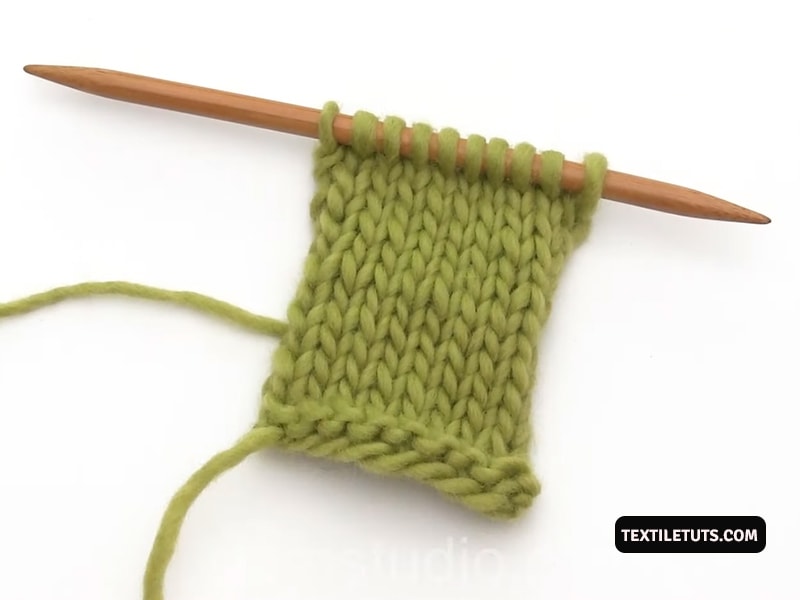What Does ‘Work Even’ Mean in Knitting?
Getting into the world of knitting isn’t an easy job, especially if you have no previous experience. Knitting instructions involve a number of shorthand terms, and understanding them can be a hassle for newbies. ‘Work Even’ is one such term that’s often used by designers.
So, what does ‘work even’ mean in knitting? In simple words, working even means you need to keep doing what you’ve been doing without any increase or decrease in the pattern. When you work even, you don’t change the stitch count or create any new shapes.
Let’s dive into the details and find out what it means to work even in knitting and how to do it.
What Does It Mean to Work Even in Knitting?

If the knitting instructions say ‘Work Even,’ it means you have to continue working the established stitch pattern without any increases or decreases in the number of stitches. Here, you’ll maintain the current stitch count while knitting the specified number of rows or rounds.
This work-even pattern is typically used to create a section of even fabric, such as in the body or sleeves of a garment where no shaping is required. In short, when you see ‘work even’ in a pattern, simply continue knitting or purling (or following the established stitch pattern) without making any changes to the stitch count.
A Basic Example of a ‘Work Even’ Knitting Pattern
Let’s say the instructions state, ‘ Work even in St st, following stripe sequence until piece measures 10 inches. Here, ‘St st’ stands for ‘stockinette stitch,’ which is a basic stitch pattern that creates a smooth, flat fabric with a ‘V’ pattern on one side and a bumpy texture on the other.
As you know by now, ‘Working even’ means to continue knitting in the same stitch pattern without increasing or decreasing stitches. A ‘stripe sequence’ refers to a pattern of alternating colors or textures that create stripes in the fabric.
So, the instruction ‘Work even in St st, following stripe sequence’ means to continue knitting in stockinette stitch without any increases or decreases while also following a specific pattern of stripes.
Finally, the instruction “until piece measures 10 inches” means that you should continue knitting in this manner until the piece you are working on measures 10 inches in length.
How Do You Work Even in Knitting?
Now that you know the meaning of working even, let’s learn how to do it. Compared to other knitting patterns and techniques, ‘work even’ is way simpler as you don’t have to worry about the stitch count or shape of the material.
To ‘work even’ while knitting, follow the steps given below:
Recognizing the Existing Pattern

Since you’ll be continuing the existing pattern while knitting, the first task is to identify the established stitch pattern; now, look at the knitting pattern of your work to determine the stitch pattern you have been using.
It could be a simple stockinette stitch (knit on the right side, purl on the wrong side), garter stitch (knit every row), ribbing, or any other stitch pattern. Once you’ve recognized the existing pattern, you just have to work even as you proceed to create the piece.
Expand the Existing Pattern

While continuing with the ‘work even’ technique, follow the pattern instructions for the specified number of rows or rounds. You need to maintain the same stitch count throughout this section.
If you’re wondering how to proceed with the existing pattern, here are two examples of the most common knitting patterns:
Stockinette Stitch

When you’re working flat (back and forth) in a stockinette stitch pattern, knit all the stitches on the right side (RS) and purl all the stitches on the wrong side (WS). If you’re working in the round, knit every stitch in every round to continue knitting using the ‘work even’ technique.
Garter Stitch

As for garter stitch patterns, if you’re working flat, knit every stitch on both the right side and the wrong side. While working in the round, alternate between knitting one round and purling the next round.
Knit Even Edges

To knit even edges, you can use a technique called “selvage” or “selvedge” stitches. It refers toedge stitches that are worked in a specific way to create a neat and even edge on your knitting project. It’s a great technique for projects like scarves, blankets, and shawls where the edges will be visible.
Here’s how to work selvage stitches:
What Does Work 3 Rows Even Mean in Knitting?

Another commonly used instruction in knitting is ‘working 3 rows even’. This particular instruction is mostly used in knitting patterns to create a section of the project where no shaping is required. ‘Work 3 rows even’ means to knit every stitch in each row without increasing or decreasing.
To work 3 rows even, simply knit every stitch in each row for three consecutive rows. It will create a section of the project where the stitch count remains the same, and the fabric is worked in a simple and even pattern.
How Does Yarn Count and GSM Impact Knitting Techniques?
When it comes to knitting techniques, understanding yarn count and GSM is crucial. The gsm to yarn count calculator helps in determining the weight and thickness of the yarn, influencing the drape, texture, and overall appearance of the knitted fabric. It’s essential for achieving the desired results in knitting projects.
Final Words
So, now you know what does ‘work even’ means in knitting. While working even, you’ll be maintaining the same number of stitches in each row without increasing or decreasing and changing the shape of the knitted piece.
To follow the technique, you need to recognize the existing pattern first. After that, you can continue expanding the pattern without making any changes to its shape and stitch count. Finally, seal the edges, and your job is done!

